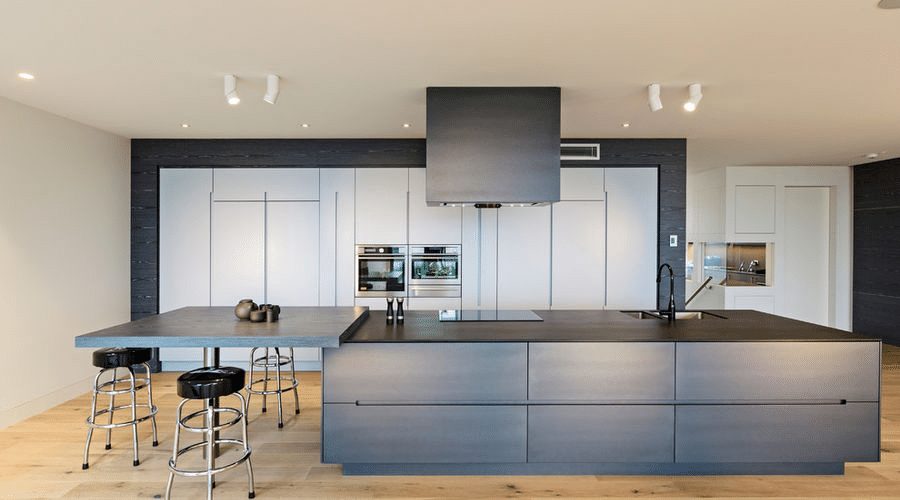Large stainless steel range hoods have been all the rage in kitchens in recent years, but we are now seeing a move toward concealed hoods. This goes hand in hand with our increasing desire for streamlined kitchens of any style.
Range hoods, which extract grease and cooking odors from the air, are useful and sometimes required by building codes. But just because you want or need one doesn’t mean that it has to be on display. Here we explain why and how you might choose to hide the hood.
Why Hide It?
A concealed or built-in range hood is integrated into the kitchen and out of sight. Hiding a hood, or any appliance for that matter, helps focus the attention on the kitchen cabinetry and other design elements, rather than on the appliance itself. Concealed hoods are especially beneficial in a small kitchen, which can get visually cluttered when lots of appliances are out in the open.
A concealed range hood can work in any style of kitchen and is especially appropriate when planning a contemporary streamlined kitchen. Concealing the hood helps maintain clean lines and avoids disrupting the continuous flow of upper cabinets, creating a sleek look.
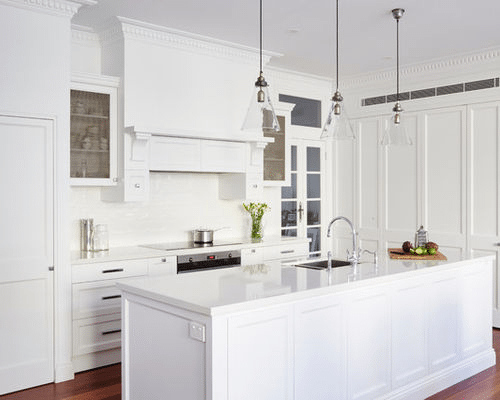
Provincial Kitchens, original photo on Houzz
Integrating range hoods into traditional-style kitchens has been a popular choice for many years. In these kitchens, hoods are often built into ornately designed custom cabinets, such as the mantelpiece-style unit pictured here. This creates a feature in a cooking area that often has a large freestanding stove as its visual centerpiece.
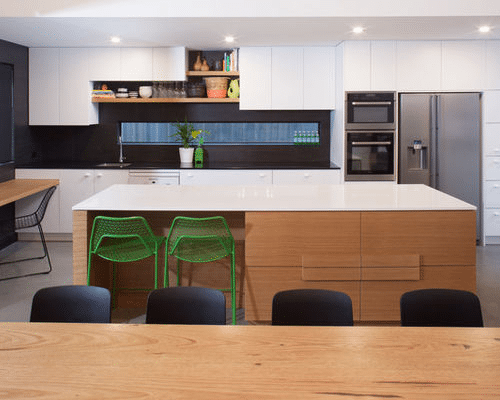
Calautti Homes, original photo on Houzz
The current trend for open shelves in the kitchen (as opposed to upper cabinets) is another design style that benefits from an integrated range hood. In this photo, the shelves are the main feature of the back wall. The hood is integrated into the upper cabinets to the right of the shelves, completely concealing it from sight. This ensures that nothing detracts from the display area.
What Are the Choices?
There are many ways in which to integrate a range hood into kitchen cabinetry and otherwise conceal it. The first step is to ensure that the hood you choose is designed to be integrated (not all are). Check with your appliance supplier and kitchen designer before buying to make sure that it will work.
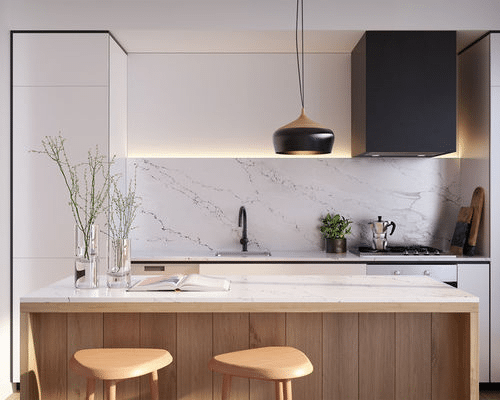
NProjects, original photo on Houzz
Inside a wall-mounted cabinet. The range hood in this kitchen is referred to as concealed, integrated or undermount. This style is tucked in an upper cabinet, and the only visible part is the bottom of the hood on the underside of the cabinet.
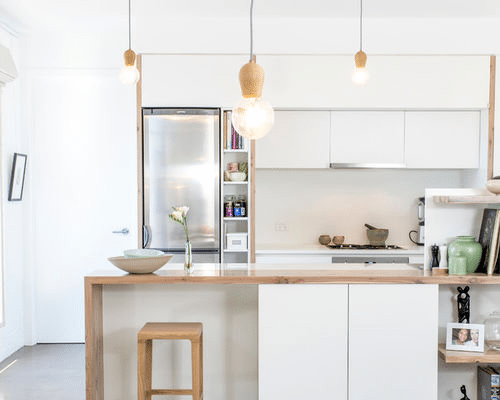
Bios Design Build Sustain, original photo on Houzz
Slide-out. Another option is a slide-out range hood, seen here built into the cabinetry above the cooktop, with just the front edge of the slide-out section showing close to the bottom of the cabinet. This section is usually finished in stainless steel; however, some models have the option to swap this out for a custom panel in the same color as the kitchen cabinets.
Slide-out hoods can be a more cost-effective alternative to completely concealed models, and they’re often available with a recirculating option for situations where ducting to the outside of the house isn’t possible (such as in an apartment or where the hood is positioned on an interior wall).
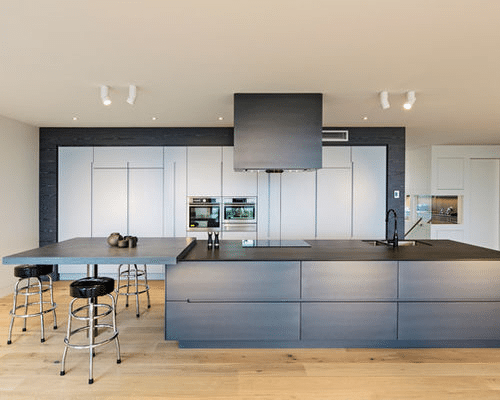
Complete Kitchens, original photo on Houzz
Above an island. The island is a popular location for cooktops since it allows the cook to converse with family and friends who are gathered around. The disadvantage of having the cooktop on an island is that positioning a range hood above it often creates an eyesore. One workaround is to build the hood into custom cabinetry that matches or complements the rest of the kitchen, as shown here.
In the ceiling. Another option for above an island is to select a range hood or exhaust system that can be built in flush with the ceiling. These hoods are generally more expensive, as they need to be extremely powerful to suck up greasy air and odors from such a distance. The advantage is that the area above the island and the view to other parts of the home beyond the hood remain unobstructed.
Downdraft. A downdraft exhaust system is one of my favorite solutions when a cooktop is on an island. It isn’t really visible unless it’s in use.
It’s built into the cabinetry below the countertop, and either behind or to the side of the cooktop, and it sits flush with the top of the counter when not in use. With the touch of a button, the exhaust fan rises to extract odors and grease from the cooking area as needed.
These units are extremely powerful and can be costly. Careful planning is required to ensure that such a ventilation system can be incorporated into a new kitchen design, as the extracted air needs to be routed to the outside through the floor. It isn’t always possible to do this in an existing home, so it may be necessary to choose a recirculating model instead.
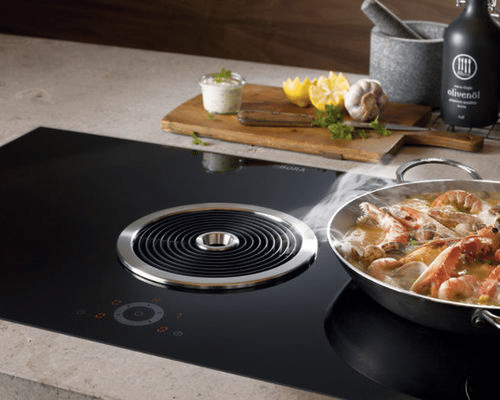
Bora, original photo on Houzz
Some top-of-the-line cooktops now have an optional built-in exhaust system. Again, these are a good choice for an island or a space where there are no upper cabinets to accommodate a concealed range hood. They operate in a similar fashion to pop-up downdraft systems, except that nothing pops up. Instead, they suck steam and odors down using powerful fans. The air then can be routed outside or cleaned and recirculated back into the room.
Induction cooktop with exhaust fan: Bora
No range hood. Building codes vary depending on your location. Some don’t require range hoods in the kitchen as long as there is adequate ventilation. This isn’t a popular choice, as most people prefer to have some means by which to quickly extract grease and odors from the air when cooking.
What Are the Cons?
A completely concealed or undermount range hood covers only about half of the cooktop below, as it fits inside a standard 12-inch-deep upper cabinet. These hoods therefore have to be more powerful to effectively suck air up from pots and pans on the front burners. This usually means that concealed hoods are more expensive than slide-out models, which pull out to cover more of the cooktop when in use and therefore don’t have to work as hard.
Another issue with a built-in hood is that the cabinetry in which it’s housed is generally custom-made to suit the hood. This can make it more difficult not only to access the relevant areas of the hood for repair, but also to find a replacement that fits into the same cabinet if the current one breaks.
Text by Anne Ellard, Houzz
Start Shopping for Your Perfect Range Hood
Unique Kitchen Lighting Options in Every Style
Contact Leading Kitchen Designers Today
